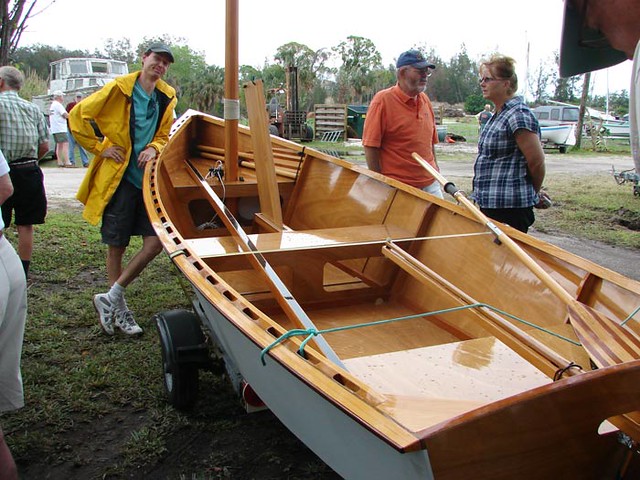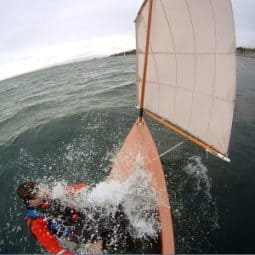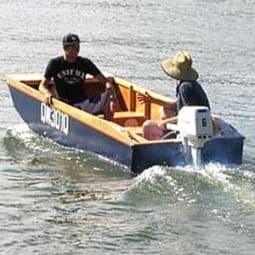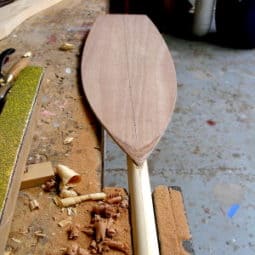Paint vs Varnish
Paint is more durable and will protect the epoxy and timber the best. But Varnish is faster and easier to apply.

Varnish hides a rough surface better. If you have done a rough job the timber grain will hide it. Make sure the varnish contains ultra-violet filters. It is a photo from the Goat Island Skiff Calendar put together by the facebook goat group.

My usual plan is to varnish the inside of open boats and decide to paint or varnish the outside. Generally if you can store the boat indoors when not in use there is no reason to not leave the outside clear finished. But it is going to be left outside much of the time I would consider a painted exterior including the gunwales and remember to leave the boat upside down.
Types of Paint and Varnish
There are two basic types of paints and varnishes.
1. Two pot – which is very hard and durable, but can be hard to get a good finish with a brush and to touch up. You have to be careful of the fumes. No primer or undercoat is required.
2. Conventional varnishes – thin with turps, are easier to put on, but may remain soft for some time. The conventional varnishes often have a better gloss and I think they are much more pleasant to use (feel nice/smell nice).
Use varnish and paints according to manufacturer’s directions.
A professional finish is 90 percent dependent on getting the surface smooth between each coat – this is the BIG secret. There are no miracle methods or products.
My tendency, for maximum durability and best appearance, would be to use a two pot polyurethane for the outside, round to the underside of the gunwale, and a varnish on the interior. For rough use I would paint the whole thing.
Consider masking off some of the floor areas with masking tape including nice rounded corners and using a non-skid finish.
A caution with conventional Turpentine based paint over epoxy
Sometimes it is said that you don’t need a primer or undercoat when painting over epoxy.
This is possibly true of two pot paints – but still it is a good idea to use a high build primer so the colour of the wood doesn’t show through the paint.
But with conventional paints I’ve experienced a problem where the final finish paint never seems to harden if applied direct over the epoxy. It just stays wet or cheesy. The way to avoid this is to dewax the epoxy carefully (unless it is one of the newer low waxing epoxies which minimise amine bloom) then sand the finish and finally to apply the undercoat recommended by the finishing paint manufacturers.
For some reason undercoat never fails to dry properly – in my experience :-)
Why I think Varnish is GREAT over epoxy
There is a very large bias against varnish. Lots of people love it but hate the perceived amount of work.
I say PERCEIVED because epoxy changes everything.
Before there were countless coats of varnish to fill up the uneven wood grain so that three good coats could go over the top.
Epoxy does can do the grain filling in one day. And if the wet on wet method is used then there is only one lot of sanding.
The varnish, sand, varnish, sand times 6 cycle or 8 cycle is gone.It can be done in four days with very easy labour – much less and easier labour than using paint.
Paint requires a LOT of work because every bump shows on the glossy surface. But varnish you can get away with murder! This is because varnished timber makes it very hard to identify the surface smoothness of the timber – there is the timber grain, there is the surface of the timber below the surface of the varnish and finally there is the refraction of the different angles of the cut off ends of the wood cells (called “figure”). A varnish job done quickly over epoxy will look a thousand percent better than a paint job done with similar speed.
It becomes:
- Dedust wood by vacumming or wiping the boat down with a clean cotton cloth
- Apply 3 coats epoxy using the Wet on Wet Method (LINK) that requires no sanding between coats. The wood grain is now filled completely.
- Powersand epoxy with a random orbit sander to remove 90 percent of the gloss. Sand the low spots with hand held sandpaper or 3M sanding pad.
- De-dust and apply first coat varnish over epoxy.
- Repeat 3 and 4 two more times. And the sanding only needs to make each surface matte (non shiny).
New Products/Methods – using a foam roller to apply paint.
I am not up to speed on it yet, but the people at Duck Flat Wooden Boats are getting excellent finishes from the new range of International/Interlux brand paints.Straight out of the can with no thinners unless it is particularly hot and dry.

They use a small (3 inch – 75mm) soft foam roller, The foam on these rollers is quite thick but the diameter is fairly small – maybe 1.5inches (37mm): in Australia they are sold under the “GEM” brand. The rollers leave a level coat and the paint levels out significantly as it dries.
There are many poor quality rollers in the market now. If possible I would buy from a specialist paint store. Or if talking on facebook or other social media as others what brands they use in your region. You can ask on our own Storer Boat Plans Group.
One trick to to run the rollers pretty dry. If there are lots of little bubbles being left behind no matter how hard you work the surface then you are using too much paint.
The result is a little short of a good average spray standard. Gloss is excellent.
Paint and Varnish Maintenance Guidelines
Hose the boat out after use.
If leaving it outdoors for extended periods turn upside down on a couple of bricks so that air can get under it and water can run off. If the epoxy coating is damaged put three coats epoxy (wet on wet) on the exposed wood and touch up with varnish or paint.
If varnish is continually exposed to sun it will need a light sand and two or three new coats every year (more frequent in the hotter states). Two pot varnish will go for a couple of years under the same conditions.
It is important not to let the timber underneath deteriorate – the whole coating will need to be sanded or scraped off and you have to start from the beginning.
With varnish the rule is that if you are trying to decide whether it needs a new coat or not, then it needs one NOW. This attitude will save you a great deal of maintenance.
Conventional paint can be given a fresh coat when it starts looking shabby (3 years?). Two pot paints should be good for 5 years or more.
Keeping the boat out of the sun will reduce need for maintenance many fold.
Our Boat Plans
Head to the main page for a list.



















